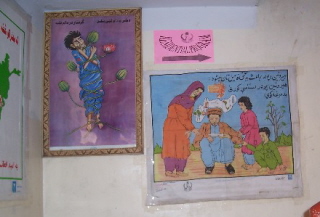Phillip S. Smith, Writer/Editor
With Afghan opium production once again at record levels this year, United Nations Afghan drug control program advisor David Macdonald's "Drugs in Afghanistan" couldn't be more timely. A sociologist with a talent for journalism, Macdonald has spent much of the last eight years in-country, traveling the length and breadth of the land, reviewing the not so voluminous literature on drug use and production, and talking to everyone from Taliban figures to warlords to opium farmers, hash smokers, and heroin injectors. The result is probably the most profound and nuanced look at the role of drugs in Afghanistan ever published.
For most Westerners, even six years after the US invasion that toppled the Taliban, Afghanistan remains a mysterious and exotic place, barely comprehensible amidst the brief flashes of illumination occasioned by intermittent attention from the West. But with years on the ground doing drug work in Afghanistan, Macdonald displays a grasp of Afghan history, culture, and society, along with a keen sense of the complexities surrounding drug production and use, that is truly inspiring.

As Macdonald wrote: "What such a search for users of snake heads and scorpion tails signifies, however, is that the search for truth about drugs and their uses in Afghanistan, like many other topics in that country, is an elusive enterprise often clouded by exaggeration, rumor, innuendo, myth, half-truths, and sheer lack of reliable information. It is the Afghan equivalent of the contemporary urban legend spread by ancient Chinese whispers, or what can be referred to as the 'scorpion tale.'"
In "Drugs in Afghanistan," Macdonald takes on the scorpion tales, bringing considerable enlightenment from the too often murky realities of the topic. Particularly important for understanding contemporary Afghan drug use and production is the historical context, and here, Macdonald shines. He explains the role of intoxicants in Islam and the contradictory pressures that shape obedience (or not) to the religion's dictate that intoxicants are haram (forbidden). He also reminds readers of the more immediate historical context of the past few decades, where the social structures that bind Afghans together have been torn asunder by years of invasion, guerrilla war, warlordism, and renewed invasion.
Macdonald traces the history of opium production in Afghanistan, the arrival of heroin laboratories in the 1970s and their expansion in the 1980s under the twin pressure of a crackdown on the Pakistani side of the invisible border and the need for anti-Soviet mujahadeen backed by the US to finance their war against the Russians. He also clarifies the role of warlords, high-level drug traffickers, and corrupt government officials in the continuing and expanding opium (and heroin) trade.

His work should hold strong cautions for Western governments, especially that of the US, calling for a massive campaign to eradicate poppies. As Macdonald shows, eradication so far has been uneven, corrupt, and detrimental to peasant livelihoods, while creating fertile recruiting ground for the Taliban. If some form of eradication is going to work, Macdonald suggests, it is going to have to be long-term, within the context of broader institution-building and development, and carefully designed to reduce the negative impact on farmers.
But while the West worries about Afghan opium headed in its direction, the other half of the story of drugs in Afghanistan is drug use by Afghans. As a drug demand reduction specialist, Macdonald is able to create a portrait of Afghan drug use that is unrivalled in anything I have ever read. From alcohol to hashish to opium to injectable heroin and a relatively new torrent of pharmaceutical intoxicants, drug use is part of Afghan culture and society. But while drug use historically took place within a structure of traditional social norms and practice, the decades of war, disruption, and dislocation that have plagued the country have produced a population that is extremely vulnerable to problematic drug use, and which is largely neglected.
Macdonald has written the book on drugs in Afghanistan. In so doing, he has provided a sterling example for anyone thinking of doing something similar with drug use and production in other countries. With its mix of economic, cultural, and historical analysis, ethnographic insight, and a humane vision of Afghans and their drug habits and problems, "Drugs in Afghanistan" should be required reading for all those policymakers sitting in Bonn or London or Washington and plotting their latest Afghan campaigns.
But anyone with an interest in the topic will be well-served indeed by Macdonald's effort. And, if you read it to the end, you will find out the truth about those scorpion tails.
Add new comment